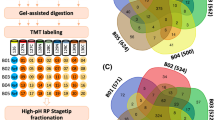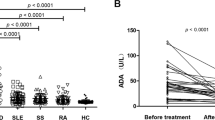Abstract
Fibromyalgia (FM) is a chronic pain syndrome with number of symptoms that present challenge in terms of diagnosis and treatment. Patients with FM show abnormal profile of purines in plasma. In this work, we measured serum activities of enzymes involved in purine metabolism, namely total adenosine deaminase (ADE) and its isoforms (ADE1 and ADE2), ecto-ATPase, and 5′-nucleotidase (5′-NT). We also measured activity of dipeptidyl peptidase IV (DPPIV) and prolyl endopeptidase (PEP). Spectrophotometric and fluorometric methods were used for enzyme activity determinations. Enzyme activities were measured in sera of 24 patients with FM that were not undergoing pharmacological treatment during the study. Control group comprised 32 healthy control subjects. Significantly higher activities of total ADE (P = 0.025) and ADE2 (P = 0.011) were observed in FM patients, while no significant differences in ADE1, ecto-ATPase, and 5′-NT activities (P > 0.05) were found when compared to healthy controls. Moreover, increase in the activity of DPPIV (P = 0.015) and lower activity of PEP (P = 0.011) were also found in the FM group. ROC analysis pointed to different diagnostic sensitivities/specificities for individual enzyme activities measured as follows: ADE (50.0/87.5), ADE2 (41.7/90.6), DPPIV (62.5/71.9), and PEP (83.3/62.5). ADE2 and PEP were shown to be independent predictors of FM, while combination of the two gives AUC of 0.786 (95 % confidence interval of 0.656–0.885, P < 0.05). Our results are showing that serum activities of ADE2 and PEP could be useful as biomarkers for FM diagnosis. However, relatively low diagnostic sensitivity of ADE2 and specificity of PEP must be taken into account.

Similar content being viewed by others
References
Wolfe F (2010) New American College of Rheumatology criteria for fibromyalgia: a twenty-year journey. Arthritis Care Res 62(5):583–584
Wolfe F, Smythe HA, Yunus MB, Benett RM, Bombardier C, Goldenberg DL, Tugwell P, Campbell SM, Abeles M, Clark P, Fam AG, Farber SJ, Fiechtner JJ, Franklin CM, Gatter RA, Hamaty D, Lessard AS, Lichtbroun AT, Masi AM, Glenn A, McCain W, Reynolds J, RomanoTJ RJ, Sheon RP (1990) The American College of Rheumatology 1990 criteria for the classification of fibromyalgia. Report of the multicenter criteria committee. Arthritis Rheum 33:160–172
Fais A, Cacace E, Corda M, Era B, Peri M, Utzeri S, Ruggiero V (2013) Purine metabolites in fibromyalgia syndrome. Clin Biochem 46(1–2):37–39
Zylka MJ (2011) Pain-relieving prospects for adenosine receptors and ectonucleotidases. Trends Mol Med 17(4):188–196
Sawynok J, Liu XJ (2003) Adenosine in the spinal cord and periphery: release and regulation of pain. Prog Neurobiol 69:313–340
Huang ZL, Zhang Z, Qu WM (2014) Roles of adenosine and its receptors in sleep-wake regulation. Int Rev Neurobiol 119:349–371
Guieu R, Guedj E, Giorgi R, Dousset A, Tuzzolino V, By Y, Leveque JM, Peragut JC, Régis J, Ruf J, Fenouillet E, Roussel P (2012) High cell surface CD26-associated activities and low plasma adenosine concentration in fibromyalgia. Ann Rheum Dis 71(8):1427–1428
Maes M, Libbrecht I, Van Hunsel F, Lin AH, Bonaccorso S, Goossens F, De Meester I, De Clerck L, Biondi M, Scharpe S, Janca A (1998) Lower serum activity of prolyl endopeptidase in fibromyalgia is related to severity of depressive symptoms and pressure hyperalgesia. Psychol Med 28(4):957–965
Kreisel W, Heussner R, Volk B, Buchsel R, Reutter W, Gerok W (1982) Identification of the 110000 Mr glycoprotein isolated from rat liver plasma membrane as dipeptidylaminopeptidase IV. FEBS Lett 147(1):85–88
Larrinaga G, Perez I, Blanco L, Sanz B, Errarte P, Beitia M, Etxezarraga MC, Loizate A, Gil J, Irazusta J, López JI (2014) Prolyl endopeptidase activity is correlated with colorectal cancer prognosis. Int J Med Sci 11(2):199–208
Culic O, Sabolic I, Zanic-Grubisic T (1990) The stepwise hydrolysis of adenine nucleotides by ectoenzymes of rat renal brush-border membranes. Biochim Biophys Acta 1030(1):143–151
Fiske CH, Subbarow Y (1925) The colorimetric determination of phosphorous. J Biol Chem 66:375–400
Yu DM, Yao TW, Chowdhury S, Nadvi NA, Osborne B, Church WB, McCaughan GW, Gorrell MD (2010) The dipeptidyl peptidase IV family in cancer and cell biology. FEBS J 277(5):1126–1144
Mendieta D, De la Cruz-Aquilera DL, Barrera-Villalpando MI, Becerril-Villanueva E, Arreola R, Hernandez-Ferreira E, Perez-Tapia SM, Perez-Sanchez G, Garces-Alvaraez ME, Aquirre-Cruz L, Velasco-Velazquez MA, Pavon T (2016) Il-8 and IL-6 primarily mediate the inflammatory response in fibromyalgia patients. J Neuroimmunol 290:22–25
Ruggiero V, Cacace E, Era B, Fais A (2016) J Musculoskelet Pain (early online 1–2)
Buljevic S, Detel D, Pucar LB, Mihelic R, Madarevic T, Sestan B, Varljen J (2013) Levels of dipeptidyl peptidase IV/CD26 substrates neuropeptide Y and vasoactive intestinal peptide in rheumatoid arthritis patients. Rheumatol Int 33(11):2867–2874
Castro-Marrero J, Cordero MD, Sáez-Francas N, Jimenez-Gutierrez C, Aguilar-Montilla FJ, Aliste L, Alegre-Martin J (2013) Could mitochondrial dysfunction be a differentiating marker between chronic fatigue syndrome and fibromyalgia? Antioxid Redox Signal 19(15):1855–1860
Acknowledgments
The authors would like to thank Dr. Larrinaga’s group, especially Dr. Maider Betia for the valuable help in the establishment of PEP activity determination method.
Author information
Authors and Affiliations
Corresponding author
Ethics declarations
The approval of the Ethical Committee was obtained, according to the principles of the Declaration of Helsinki and all the International Conferences on Harmonization and Good Clinical Practice Guidelines. All the participants involved in the study gave their written informed consent before initiating the study.
Disclosures
None.
Rights and permissions
About this article
Cite this article
Čulić, O., Cordero, M.D., Žanić-Grubišić, T. et al. Serum activities of adenosine deaminase, dipeptidyl peptidase IV and prolyl endopeptidase in patients with fibromyalgia: diagnostic implications. Clin Rheumatol 35, 2565–2571 (2016). https://doi.org/10.1007/s10067-016-3377-8
Received:
Revised:
Accepted:
Published:
Issue Date:
DOI: https://doi.org/10.1007/s10067-016-3377-8




